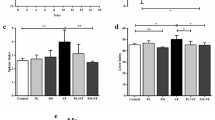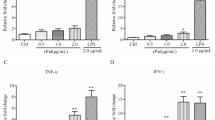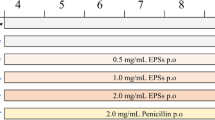Abstract
Objective and design
Laticifer proteins (LP) of Calotropis procera were fractionated by ion-exchange chromatography, and the influence of a sub-fraction (LPPI) on the inflammatory response of Swiss mice challenged by Salmonella enterica Ser. Typhimurium was investigated.
Methods
Mice (n = 10) received LPPI (30 or 60 mg/kg) in a single inoculum by the intraperitoneal route 24 h before infection. To investigate the relevance of the proteolytic activity, three additional groups were included: the first one received heat-treated LP (30 mg/kg—30 min at 100 °C), the second received LP (30 mg/kg) inactivated by iodoacetamide, and a control group received only phosphate-buffered saline (PBS).
Results
The survival rate reached 100 % in mice treated with LPPI and was also observed with the other treatment, whereas the PBS group died 1–3 days after infection. The neutrophil infiltration into the peritoneal cavity of pretreated mice was enhanced and accompanied by high bacterial clearance from the bloodstream. Tumor necrosis factor-alpha mRNA transcripts, but not interferon-gamma, were detected early in spleen cells of pretreated mice after infection; however, the nitric oxide contents in the bloodstream were decreased in comparison to the PBS group.
Conclusions
The inflammatory stimulus of C. procera proteins increased phagocytosis and balanced the nitric oxide release in the bloodstream, preventing septic shock induced by Salmonella infection.






Similar content being viewed by others
References
Seo CS, Lee YK, Kim YJ, Jung JS, Jahng Y, Chang HW, Song DK, Son JK. Protective effect of lignans against sepsis from the roots of Saururus chinensis. Biol Pharm Bull. 2008;31:523–6.
Garrido G, Delgado R, Lemus Y, Rodríguez J, García D, Núñez-Sellés AJ. Protection against septic shock and suppression of tumor necrosis factor alpha and nitric oxide production on macrophages and microglia by a standard aqueous extract of Mangifera indica L. (VIMANG®) Role of mangiferin isolated from the extract. Pharmacol Res. 2004;50:165–72.
Chan MM, Fong D, Ho C, Huang H. Inhibition of inducible nitric oxide synthase gene expression and enzyme activity by epigallocatechin gallate, a natural product from green tea. Biochem Pharmacol. 1997;54:1281–6.
Rasik AM, Raghubir R, Gupta A, Shukla A, Dubey MP, Srivastava S, Jain HK, Kulshrestha DK. Healing potential of Calotropis procera on dermal wounds in Guinea pigs. J Ethnopharmacol. 1999;68:261–6.
Dewan S, Kumar S, Kumar VL. Antipyretic effect of latex of Calotropis procera. Ind J Pharmacol. 2000;32:247–52.
Arya S, Kumar VL. Anti-inflammatory efficacy of extracts of latex of Calotropis procera against different mediators of inflammation. Mediators Inflamm. 2008;4:228–32.
Choedon T, Mathan G, Arya S, Kumar VL, Kumar V. Anticancer and cytotoxic properties of the latex of Calotropis procera in a transgenic mouse model of hepatocellular carcinoma. World J Gastroenterol. 2006;12:2517–22.
El Badwi SMA, Bakhiet AO. Toxicity of Calotropis procera latex in pregnant and non-pregnant goats. Sci Res Essays. 2010;5:2404–8.
Kumar VL, Chaudhary P, Ramos MV, Mohan M, Matos MPV. Protective effect of proteins derived from the latex of Calotropis procera against inflammatory hyperalgesia in monoarthritic rats. Phytother Res. 2011. doi:10.1002/ptr.3428.
Parabia FM, Kothari IL, Parabia MH. Antibacterial activity of solvent fractions of crude water decoction of apical twigs and latex of Calotropis procera (Ait.) R. Br. Nat Prod Radiance. 2008;7:30–4.
Alencar NMN, Oliveira JS, Mesquita RO, Lima MW, Vale MR, Etchells JP, Freitas CDT, Ramos MV. Pro- and antiinflammatory activities of the latex from Calotropis procera (Ait.) R.Br. are trigged by compounds fractionated by dialysis. Inflamm Res. 2006;55:559–64.
Alencar NMN, Figueredo IST, Vale MR, Bitencurt FS, Oliveira JS, Ribeiro RA, Ramos MV. Anti-inflammatory effect of the latex from Calotropis procera in: three different experimental models: peritonitis, paw edema and hemorrhagic cystitis. Planta Med. 2004;7:1144–9.
Oliveira JS, Freitas CDT, Moraes MO, Pessoa C, Costa-Lotufo LV, Ramos MV. In vitro cytotoxicity against different human cancer cell lines of laticifer proteins of Calotropis procera (Ait.) R.Br. Toxicol In Vitro. 2007;21:1563–73.
Freitas CDT, Oliveira JS, Miranda MRA, Macedo NMR, Sales MP, Villas-Boas LA, Ramos MV. Enzymatic activities and protein profile of latex from Calotropis procera. Plant Physiol Biochem. 2007;45:781–9.
Craik CS, Page MJ, Madison EL. Proteases as therapeutics. Biochem J. 2011;1435:1–16.
Salas CE, Gomes MTR, Hernandez M, Lopes MTP. Plant cysteine proteinases: evaluation of the pharmacological activity. Phytochemistry. 2008;69:2263–9.
Lima-Filho JV, Patriota JM, Silva AFB, Pontes-Filho NT, Oliveira RSB, Alencar NMN, Ramos MV. Proteins from latex of Calotropis procera prevent septic shock due to lethal infection by Salmonella enterica serovar Typhimurium. J Ethnopharmacol. 2010;129:327–34.
Ramos MV, Oliveira JS, Figueiredo JG, Figueiredo IST, Kumar VL, Bitencurt FS, Cunha FQ, Oliveira RSB, Bomfim LR, Lima-Filho JV, Ramos MV. Involvement of NO in the inhibitory effect of Calotropis procera latex protein fractions on leukocyte rolling, adhesion and infiltration in rat peritonitis model. J Ethnopharmacol. 2009;125:1–10.
Lima-Filho JVM, Vieira LQ, Arantes RME, Nicoli JR. Effect of the Escherichia coli EMO strain on experimental infection by Salmonella enterica serovar Typhimurium in gnotobiotic mice. Braz J Med Biol Res. 2004;37:1005–13.
Souza GEP, Ferreira SH. Blockade by anti-macrophages serum of the migration of PMN neutrophilis into the inflamed peritoneal cavity. Agent Actions. 1985;17:97–103.
Gilliland G, Perrin S, Blanchard K, Bunn HF. Genetics analysis of cytokine mRNA and DNA: detection and quantitation by competitive polymerase chain reaction. Proc Natl Acad Sci USA. 1990;87:2725–9.
Chen CC, Lin YC, Chen SA, Luk HN, Ding PY, Chang MS, Chiang CE. Shortening of cardiac action potentials in endotoxic shock in guinea pigs is caused by an increase in nitric oxide activity and activation of the adenosine triphosphate-sensitive potassium channel. Crit Care Med. 2000;28:1713–20.
Guisti G. Adenosine deaminase. In: Ulrich Hans, editor. Methods of enzymatic analyses. New York: Bergmeyer, Academic Press; 1974.
Portillo FG. Salmonella intracellular proliferation: where, when and how? Microb Infect. 2001;3:1305–11.
John B, Rajagopal D, Pashine A, Rath S, George A, Bal V. Role of IL-12-independent and IL-12-dependent pathways in regulating generation of the IFN-gamma component of T cell responses to Salmonella typhimurium. J Immunol. 2002;169:2545–52.
Withanage GSK, Wigley P, Kaiser P, Mastroeni P, Brooks H, Powers C, Beal R, Barrow P, Maskell DM. Cytokine and chemokine responses associated with clearance of a primary Salmonella enterica Serovar Typhimurium infection in the chicken and in protective immunity to rechallenge. Infect Immun. 2005;73:456–60.
Mastroeni P. Immunity to systemic Salmonella infections. Curr Mol Med. 2002;2:393–406.
Pérez-Sola MJ, Torre-Cisneros J, Pérez-Zafrilla P, Carmona L, Descalzo MA, Gómez-Reino JJ. Infections in patients treated with tumor necrosis factor antagonists: incidence, etiology and mortality in the BIOBADASER registry. Med Clin (Barc). 2011;137(12):533–40.
Kirkebøen KA, Strand ØA. The role of nitric oxide in sepsis—an overview. Acta Anaesthesiol Scand. 1999;43:275–88.
Guzik TJ, Korbut R, Adamak-Guzik T. Nitric oxide and superoxide in inflammation and immune regulation. J Physiol Pharmacol. 2003;54:469–87.
Schwacha MG, Meissler JJ Jr, Eisenstein TK. Salmonella typhimurium infection in mice induces nitric oxide-mediated immunosuppression through a natural killer cell-dependent pathway. Infect Immun. 1998;66:5862–6.
Al-Ramadi BK, Brodkin MA, Mosser DM, Eisenstein TK. Immunosuppression induced by attenuated Salmonella: evidence for mediation by macrophage precursors. J Immunol. 1991;146:2737–46.
Link AA, Kino T, Worth JA, McGuire JL, Crane ML, Chrousos GP, Wilder RL, Elenkov IJ. Ligand-activation of the adenosine A2a receptors inhibits IL-12 production by human monocytes. J Immunol. 2000;164:436–42.
Kreckler LM, Wan TC, Ge ZD, Auchampach JA. Adenosine inhibits tumor necrosis factor-α release from mouse peritoneal macrophages via A2A and A2B but not the A3 adenosine receptor. J Pharmacol Exp Ther. 2006;317:172–80.
Rishi P, Rampuria A, Tewari R, Koul A. Phytomodulatory potentials of Aloe vera against Salmonella OmpR-mediated inflammation. Phytother Res. 2008;22:1075–82.
Adamou JE, Heinrichs JH, Erwin A, Walsh H, Gayle T, Dormitzer M, Dagan R, Brewah YA, Barren P, Lathigra R, Langermann S, Koenig S, Johnson S. Identification and characterization of a novel family of pneumococcal proteins that are protective against sepsis. Infect Immun. 2001;69:949–58.
Acknowledgments
The biochemical, functional and applied studies of the latex proteins from Calotropis procera were supported by grants from FUNCAP and CNPq (Universal, RENORBIO and Brazil/India cooperation). We also thank the Educational Tutorial Program (MEC/SESu) for scholarship support.
Conflict of interest
The authors declare that there is no conflict of interests.
Author information
Authors and Affiliations
Corresponding authors
Additional information
Responsible Editor: Artur Bauhofer.
Rights and permissions
About this article
Cite this article
Oliveira, R.S.B., Figueiredo, I.S.T., Freitas, L.B.N. et al. Inflammation induced by phytomodulatory proteins from the latex of Calotropis procera (Asclepiadaceae) protects against Salmonella infection in a murine model of typhoid fever. Inflamm. Res. 61, 689–698 (2012). https://doi.org/10.1007/s00011-012-0460-8
Received:
Revised:
Accepted:
Published:
Issue Date:
DOI: https://doi.org/10.1007/s00011-012-0460-8




